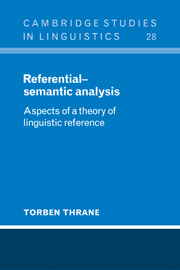Book contents
- Frontmatter
- Contents
- Preface
- Introduction: The functions of language
- PART I THE PRELIMINARIES
- PART II THE THEORY
- 3 SOME FUNDAMENTAL NOTIONS
- 4 THE BASIS OF RS-ANALYSIS
- 5 REFERENTIAL–SEMANTIC FEATURES
- 6 SUBJUNCTION AND ADJUNCTION
- PART III THE APPLICATION
- CONCLUSION: SUMMARY AND FURTHER PROSPECTS
- Bibliography
- Index
5 - REFERENTIAL–SEMANTIC FEATURES
Published online by Cambridge University Press: 06 August 2010
- Frontmatter
- Contents
- Preface
- Introduction: The functions of language
- PART I THE PRELIMINARIES
- PART II THE THEORY
- 3 SOME FUNDAMENTAL NOTIONS
- 4 THE BASIS OF RS-ANALYSIS
- 5 REFERENTIAL–SEMANTIC FEATURES
- 6 SUBJUNCTION AND ADJUNCTION
- PART III THE APPLICATION
- CONCLUSION: SUMMARY AND FURTHER PROSPECTS
- Bibliography
- Index
Summary
Features on FC
It is assumed that FC dominates linguistic material that would be interpreted as having grammatical or functional meaning, such as the articles, (other) determiners, quantifiers, and classifiers, whereas the denotative categories (L) dominate material that would be interpreted as having lexical meaning. The present section will be devoted to an account of the – functional – features on FC. The – lexical – features on L will be dealt with in §5.3. Cf. Bierwisch (1971) for detailed arguments in favour of a similar distinction between two comparable types of semantic features.
Central to the present account are the traditional grammatical categories – case, gender, tense, mood, etc. – among which standard descriptions of the (classical) Indo-European languages usually recognize as the indispensable nominal categories the following: case, gender, number, and person. Views differ as to whether definiteness should be accorded categorial status (possibly subsumed under the label ‘article’) on a par with these four, and the status of person as a purely nominal category is sometimes disputed.
There are good reasons not to regard either definiteness or person as being of the same primitive status as case, gender, and number (see §§8.1, 10.2.2 for details), and there are further good reasons to suppose that these three primitive categories must be supplemented with yet a fourth which is not normally given independent categorial status, namely, countability (cf. §5.1.3).
- Type
- Chapter
- Information
- Referential-Semantic AnalysisAspects of a Theory of Linguistic Reference, pp. 74 - 101Publisher: Cambridge University PressPrint publication year: 1980



